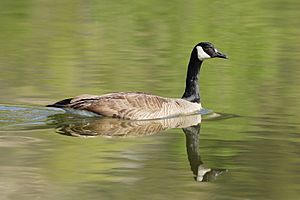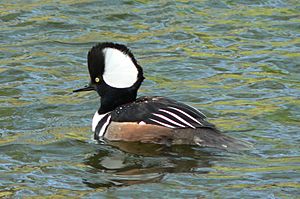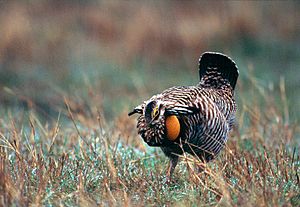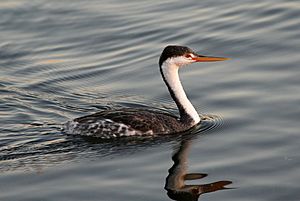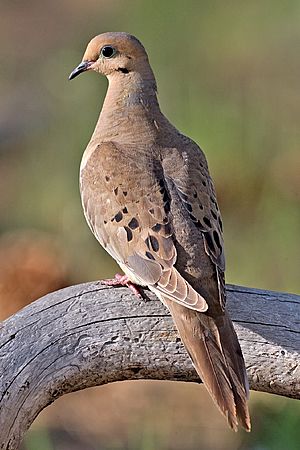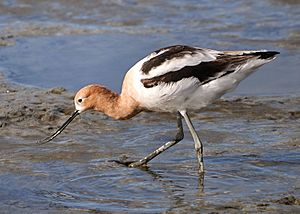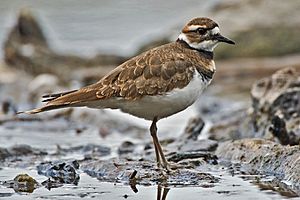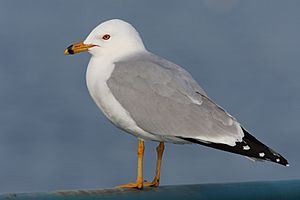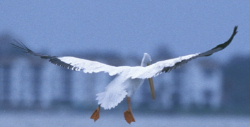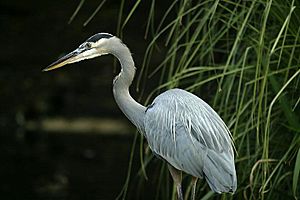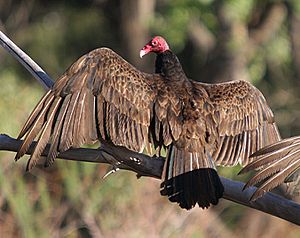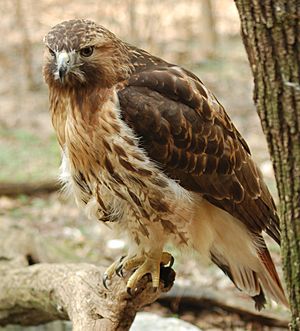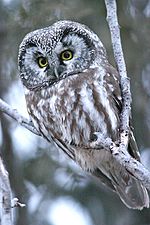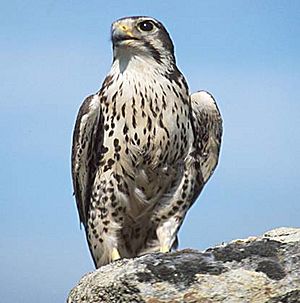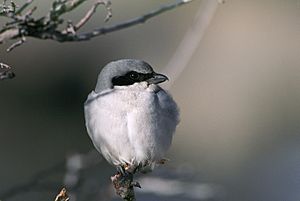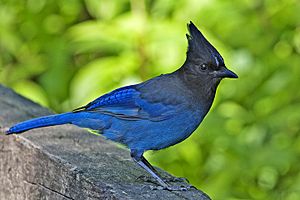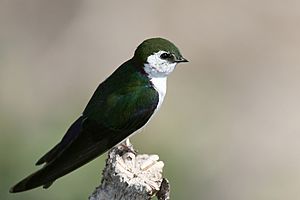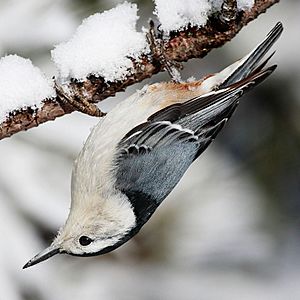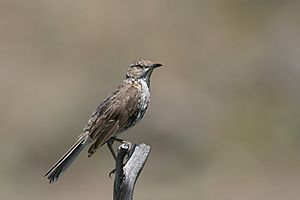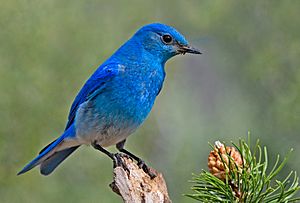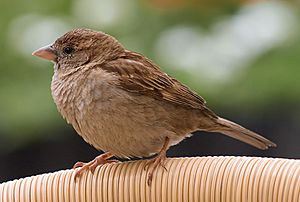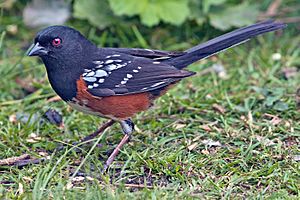List of birds of Wyoming facts for kids
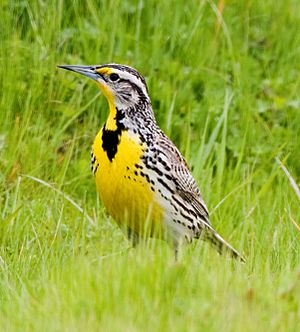
This list shows the different types of birds found in Wyoming, a state in the United States. The Wyoming Game and Fish Department (WGFD) has recorded these birds up to May 2021. There are 452 bird species on this list. About 118 of them are considered accidental visitors. This means they don't usually live in Wyoming but show up there sometimes. Seven species have been introduced to North America by people.
This list follows the order from the Check-list of North and Middle American Birds, which is made by the American Ornithological Society (AOS). The names of the bird families come from the Clements taxonomy.
Most birds on this list live in Wyoming regularly. Some are permanent residents, while others visit in summer or winter, or just pass through during migration. Here are some special notes for certain birds:
- (A) Accidental: These birds show up in Wyoming by chance, not regularly.
- (I) Introduced: These birds were brought to North America by humans and now live there.
Contents
- Water Birds: Ducks, Geese, and Swans
- Quails of the New World
- Game Birds: Pheasants and Grouse
- Grebes: Diving Birds
- Pigeons and Doves
- Cuckoos and Roadrunners
- Nightjars and Nighthawks
- Swifts: Fast Fliers
- Hummingbirds: Tiny Wonders
- Rails, Gallinules, and Coots
- Cranes: Tall Wading Birds
- Stilts and Avocets
- Plovers and Lapwings
- Sandpipers and Shorebirds
- Gulls, Terns, and Skimmers
- Loons: Diving Water Birds
- Pelicans: Birds with Pouches
- Herons, Egrets, and Bitterns
- Ibises and Spoonbills
- New World Vultures
- Osprey: Fish-Eating Bird of Prey
- Hawks, Eagles, and Kites
- Barn-Owls
- Owls: Night Hunters
- Kingfishers
- Woodpeckers: Tree Tappers
- Falcons and Caracaras
- Tyrant Flycatchers
- Vireos
- Shrikes: Impaling Hunters
- Crows, Jays, and Magpies
- Chickadees and Titmice
- Larks: Ground Birds with Songs
- Swallows: Aerial Feeders
- Long-tailed Tits
- Kinglets: Tiny Crowned Birds
- Waxwings: Silky Plumage Birds
- Nuthatches: Head-First Climbers
- Treecreepers
- Gnatcatchers
- Wrens: Small but Loud
- Mockingbirds and Thrashers
- Starlings
- Dippers
- Thrushes and Allies
- Old World Sparrows
- Wagtails and Pipits
- Finches and Allies
- Longspurs and Snow Buntings
- New World Sparrows
- Yellow-breasted Chat
- Troupials and Allies
- New World Warblers
- Cardinals and Allies
- See also
Water Birds: Ducks, Geese, and Swans
Order: Anseriformes (Waterfowl) Family: Anatidae (Ducks, Geese, Swans)
The Anatidae family includes ducks, geese, and swans. These birds are great at living in water. They have webbed feet, flat bills, and special oily feathers that shed water easily. Forty-one types of these birds have been seen in Wyoming.
- Snow goose, Anser caerulescens
- Ross's goose, Anser rossii
- Greater white-fronted goose, Anser albifrons
- Brant, Branta bernicla (A)
- Cackling goose, Branta hutchinsii (A)
- Canada goose, Branta canadensis
- Trumpeter swan, Cygnus buccinator
- Tundra swan, Cygnus columbianus
- Whooper swan, Cygnus cygnus (A)
- Wood duck, Aix sponsa
- Garganey, Spatula querquedula (A)
- Blue-winged teal, Spatula discors
- Cinnamon teal, Spatula cyanoptera
- Northern shoveler, Spatula clypeata
- Gadwall, Mareca strepera
- Eurasian wigeon, Mareca penelope (A)
- American wigeon, Mareca americana
- Mallard, Anas platyrhynchos
- Mexican duck, Anas diazi (A)
- American black duck, Anas rubripes (A)
- Mottled duck, Anas fulvigula (A)
- Northern pintail, Anas acuta
- Green-winged teal, Anas crecca
- Canvasback, Aythya valisineria
- Redhead, Aythya americana
- Ring-necked duck, Aythya collaris
- Tufted duck, Aythya fuligula (A)
- Greater scaup, Aythya marila
- Lesser scaup, Aythya affinis
- Harlequin duck, Histrionicus histrionicus
- Surf scoter, Melanitta perspicillata
- White-winged scoter, Melanitta deglandi
- Black scoter, Melanitta americana (A)
- Long-tailed duck, Clangula hyemalis
- Bufflehead, Bucephala albeola
- Common goldeneye, Bucephala clangula
- Barrow's goldeneye, Bucephala islandica
- Hooded merganser, Lophodytes cucullatus
- Common merganser, Mergus merganser
- Red-breasted merganser, Mergus serrator
- Ruddy duck, Oxyura jamaicensis
Quails of the New World
Order: Galliformes (Gamefowl) Family: Odontophoridae (New World Quail)
New World quails are small, round birds that live on the ground. They are not closely related to Old World quails, but they look and act similarly. Two species have been seen in Wyoming.
- Northern bobwhite, Colinus virginianus
- California quail, Callipepla californica (A)
Game Birds: Pheasants and Grouse
Order: Galliformes (Gamefowl) Family: Phasianidae (Pheasants, Grouse, Allies)
This family includes pheasants and similar birds. They live on land and vary in size. They are usually plump with short, wide wings. Many of these birds are hunted for sport or raised for food. Ten species have been found in Wyoming.
- Wild turkey, Meleagris gallopavo
- Ruffed grouse, Bonasa umbellus
- Greater sage-grouse, Centrocercus urophasianus
- White-tailed ptarmigan, Lagopus leucurus
- Dusky grouse, Dendragapus obscurus
- Sharp-tailed grouse, Tympanuchus phasianellus
- Greater prairie-chicken, Tympanuchus cupido (A)
- Gray partridge, Perdix perdix (I)
- Ring-necked pheasant, Phasianus colchicus (I)
- Chukar, Alectoris chukar (I)
Grebes: Diving Birds
Order: Podicipediformes (Grebes) Family: Podicipedidae (Grebes)
Grebes are small to medium-sized birds that dive in freshwater. They have lobed toes, making them excellent swimmers and divers. However, their feet are set far back on their bodies, so they are clumsy on land. Six species have been recorded in Wyoming.
- Pied-billed grebe, Podilymbus podiceps
- Horned grebe, Podiceps auritus
- Red-necked grebe, Podiceps grisegena (A)
- Eared grebe, Podiceps nigricollis
- Western grebe, Aechmorphorus occidentalis
- Clark's grebe, Aechmorphorus clarkii
Pigeons and Doves
Order: Columbiformes (Pigeons and Doves) Family: Columbidae (Pigeons and Doves)
Pigeons and doves are birds with sturdy bodies, short necks, and thin bills. Five species have been seen in Wyoming.
- Rock pigeon, Columba livia (I)
- Band-tailed pigeon, Patagioenas fasciata
- Eurasian collared-dove, Streptopelia decaocto (I)
- White-winged dove, Zenaida asiatica (A)
- Mourning dove, Zenaida macroura
Cuckoos and Roadrunners
Order: Cuculiformes (Cuckoos) Family: Cuculidae (Cuckoos)
This family includes cuckoos, roadrunners, and anis. These birds vary in size and have slender bodies, long tails, and strong legs. Two species have been recorded in Wyoming.
- Yellow-billed cuckoo, Coccyzus americanus
- Black-billed cuckoo, Coccyzus erythropthalmus
Nightjars and Nighthawks
Order: Caprimulgiformes (Nightjars) Family: Caprimulgidae (Nightjars and Allies)
Nightjars are medium-sized birds that are active at night. They usually build their nests on the ground. They have long wings, short legs, and very short bills. Their soft feathers are colored to help them blend in with tree bark or leaves. Three species have been found in Wyoming.
- Lesser nighthawk, Chordeiles acutipennis (A)
- Common nighthawk, Chordeiles minor
- Common poorwill, Phalaenoptilus nuttallii
Swifts: Fast Fliers
Order: Apodiformes (Swifts and Hummingbirds) Family: Apodidae (Swifts)
Swifts are small birds that spend most of their lives flying. They have very short legs and almost never land on the ground. Instead, they perch on vertical surfaces. Many swifts have long, swept-back wings that look like a crescent moon. Four species have been recorded in Wyoming.
- Black swift, Cypseloides niger
- Chimney swift, Chaetura pelagica
- Vaux's swift, Chaetura vauxi (A)
- White-throated swift, Aeronautes saxatalis
Hummingbirds: Tiny Wonders
Order: Apodiformes (Swifts and Hummingbirds) Family: Trochilidae (Hummingbirds)
Hummingbirds are tiny birds that can hover in the air by flapping their wings very fast. They are the only birds that can fly backward! Seven species have been seen in Wyoming.
- Rivoli's hummingbird, Eugenes fulgens (A)
- Ruby-throated hummingbird, Archilochus colubris (A)
- Black-chinned hummingbird, Archilochus alexandri
- Anna's hummingbird, Calypte anna (A)
- Calliope hummingbird, Selasphorus calliope
- Rufous hummingbird, Selasphorus rufus
- Broad-tailed hummingbird, Selasphorus platycercus
Rails, Gallinules, and Coots
Order: Gruiformes (Cranes, Rails, Allies) Family: Rallidae (Rails, Gallinules, Coots)
Rallidae is a large family of small to medium-sized birds. This group includes rails, crakes, coots, and gallinules. They usually live in thick plants near lakes, swamps, or rivers. They are often shy and hard to spot. Most have strong legs and long toes, which help them walk on soft, uneven ground. They tend to have short, rounded wings and are not strong fliers. Seven species have been recorded in Wyoming.
- Virginia rail, Rallus limicola
- Sora, Porzana carolina
- Common gallinule, Gallinula galeata (A)
- American coot, Fulica americana
- Purple gallinule, Porphyrio martinicus (A)
- Yellow rail, Coturnicops noveboracensis (A)
- Black rail, Laterallus jamaicensis (A)
Cranes: Tall Wading Birds
Order: Gruiformes (Cranes, Rails, Allies) Family: Gruidae (Cranes)
Cranes are large birds with long legs and long necks. Unlike herons, which look similar, cranes fly with their necks stretched out. Most cranes have fancy and loud dances they perform when looking for a mate. Two species have been recorded in Wyoming.
- Sandhill crane, Antigone canadensis
- Whooping crane, Grus americana
Stilts and Avocets
Order: Charadriiformes (Shorebirds, Gulls, Auks) Family: Recurvirostridae (Stilts and Avocets)
This family includes avocets and stilts, which are large wading birds. Avocets have long legs and bills that curve upwards. Stilts have extremely long legs and long, thin, straight bills. Two species have been recorded in Wyoming.
- Black-necked stilt, Himantopus mexicanus
- American avocet, Recurvirostra americana
Plovers and Lapwings
Order: Charadriiformes (Shorebirds, Gulls, Auks) Family: Charadriidae (Plovers and Lapwings)
The Charadriidae family includes plovers, dotterels, and lapwings. They are small to medium-sized birds with compact bodies, short thick necks, and long, pointed wings. They live in open areas worldwide, often near water. Seven species have been recorded in Wyoming.
- Black-bellied plover, Pluvialis squatarola
- American golden-plover, Pluvialis dominica
- Killdeer, Charadrius vociferus
- Semipalmated plover, Charadrius semipalmatus
- Piping plover, Charadrius melodus
- Snowy plover, Charadrius nivosus
- Mountain plover, Charadrius montanus
Sandpipers and Shorebirds
Order: Charadriiformes (Shorebirds, Gulls, Auks) Family: Scolopacidae (Sandpipers and Allies)
Scolopacidae is a large and varied family of small to medium-sized shorebirds. It includes sandpipers, curlews, godwits, and many others. Most of these birds eat small bugs they find in mud or soil. Different bill and leg lengths allow many species to feed in the same places without competing for food. Twenty-nine species have been recorded in Wyoming.
- Upland sandpiper, Bartramia longicauda
- Whimbrel, Numenius phaeopus
- Long-billed curlew, Numenius americanus
- Hudsonian godwit, Limosa haemastica
- Marbled godwit, Limosa fedoa
- Ruddy turnstone, Arenaria interpres
- Red knot, Calidris canutus
- Stilt sandpiper, Calidris himantopus
- Sanderling, Calidris alba
- Dunlin, Calidris alpina
- Baird's sandpiper, Calidris bairdii
- Least sandpiper, Calidris minutilla
- White-rumped sandpiper, Calidris fuscicollis
- Buff-breasted sandpiper, Calidris subruficollis
- Pectoral sandpiper, Calidris melanotos
- Semipalmated sandpiper, Calidris pusilla
- Western sandpiper, Calidris mauri
- Short-billed dowitcher, Limnodromus griseus
- Long-billed dowitcher, Limnodromus scolopaceus
- American woodcock, Scolopax minor (A)
- Wilson's snipe, Gallinago delicata
- Spotted sandpiper, Actitis macularius
- Solitary sandpiper, Tringa solitaria
- Lesser yellowlegs, Tringa flavipes
- Willet, Tringa semipalmata
- Greater yellowlegs, Tringa melanoleuca
- Wilson's phalarope, Phalaropus tricolor
- Red-necked phalarope, Phalaropus lobatus
- Red phalarope, Phalaropus fulicarius (A)
Gulls, Terns, and Skimmers
Order: Charadriiformes (Shorebirds, Gulls, Auks) Family: Laridae (Gulls, Terns, Skimmers)
Laridae is a family of medium to large seabirds. It includes gulls, terns, and skimmers. They are usually gray or white, often with black marks on their heads or wings. They have strong, longish bills and webbed feet. Twenty-two species have been recorded in Wyoming.
- Black-legged kittiwake, Rissa tridactyla (A)
- Sabine's gull, Xema sabini
- Bonaparte's gull, Chroicocephalus philadelphia
- Black-headed gull, Chroicocephalus ridibundus (A)
- Little gull, Hydrocoloeus minutus (A)
- Ross's gull, Rhodostethia rosea (A)
- Laughing gull, Leucophaeus atricilla (A)
- Franklin's gull, Leucophaeus pipixcan
- Heermann's gull, Larus heermanni (A)
- Short-billed gull, Larus brachyrhynchus (A)
- Ring-billed gull, Larus delawarensis
- California gull, Larus californicus
- Herring gull, Larus argentatus
- Iceland gull, Larus glaucoides (A)
- Lesser black-backed gull, Larus fuscus (A)
- Glaucous-winged gull, Larus glaucescens (A)
- Glaucous gull, Larus hyperboreus (A)
- Great black-backed gull, Larus marinus (A)
- Least tern, Sternula antillarum (A)
- Caspian tern, Hydroprogne caspia
- Black tern, Chlidonias niger
- Common tern, Sterna hirundo
- Arctic tern, Sterna paradisaea (A)
- Forster's tern, Sterna forsteri
Loons: Diving Water Birds
Order: Gaviiformes (Loons) Family: Gaviidae (Loons)
Loons are water birds about the size of a large duck, but they are not related to ducks. They are mostly gray or black and have spear-shaped bills. Loons swim well and fly okay, but they are very clumsy on land because their legs are placed far back on their bodies. Four species have been recorded in Wyoming.
- Red-throated loon, Gavia stellata
- Pacific loon, Gavia pacifica
- Common loon, Gavia immer
- Yellow-billed loon, Gavia adamsii (A)
Pelicans: Birds with Pouches
Order: Pelecaniformes (Pelicans, Herons, Ibises) Family: Pelecanidae (Pelicans)
Pelicans are very large water birds with a special pouch under their beak. Like other birds in their group, they have four webbed toes. Two species have been recorded in Wyoming.
- American white pelican, Pelecanus erythrorhynchos
- Brown pelican, Pelecanus occidentalis (A)
Herons, Egrets, and Bitterns
Order: Pelecaniformes (Pelicans, Herons, Ibises) Family: Ardeidae (Herons, Egrets, Bitterns)
The Ardeidae family includes herons, egrets, and bitterns. Herons and egrets are medium to large wading birds with long necks and legs. Bitterns have shorter necks and are more secretive. These birds fly with their necks pulled back, unlike storks or ibises. Eleven species have been recorded in Wyoming.
- American bittern, Botaurus lentiginosus
- Least bittern, Ixobrychus exilis (A)
- Great blue heron, Ardea herodias
- Great egret, Ardea alba (A)
- Snowy egret, Egretta thula
- Little blue heron, Egretta caerulea (A)
- Tricolored heron, Egretta tricolor (A)
- Cattle egret, Bubulcus ibis
- Green heron, Butorides virescens
- Black-crowned night-heron Nycticorax nycticorax
- Yellow-crowned night-heron, Nyctanassa violacea (A)
Ibises and Spoonbills
Order: Pelecaniformes (Pelicans, Herons, Ibises) Family: Threskiornithidae (Ibises and Spoonbills)
This family includes ibises and spoonbills. They have long, wide wings and long bodies, necks, and legs. Their bills are also long; ibises have down-curved bills, while spoonbills have flat, spoon-shaped bills. Three species have been recorded in Wyoming.
- White ibis, Eudocimus albus (A)
- Glossy ibis, Plegadis falcinellus (A)
- White-faced ibis, Plegadis chihi
New World Vultures
Order: Cathartiformes (New World Vultures) Family: Cathartidae (New World Vultures)
New World vultures look like Old World vultures, but they are not closely related. They both eat dead animals. Unlike Old World vultures, which find food by sight, New World vultures have a good sense of smell to find carcasses. Three species have been recorded in Wyoming.
- California condor, Gymnogyps californianus (A)
- Black vulture, Coragyps atratus (A)
- Turkey vulture, Cathartes aura
Osprey: Fish-Eating Bird of Prey
Order: Accipitriformes (Hawks, Eagles, Kites) Family: Pandionidae (Osprey)
The Pandionidae family has only one type of bird: the osprey. Ospreys are fish-eating birds of prey. They have a very large, strong, hooked beak to tear meat, strong legs, powerful claws, and excellent eyesight.
- Osprey, Pandion haliaetus
Hawks, Eagles, and Kites
Order: Accipitriformes (Hawks, Eagles, Kites) Family: Accipitridae (Hawks, Eagles, Kites)
Accipitridae is a family of birds of prey. It includes hawks, eagles, kites, and harriers. These birds have very large, strong, hooked beaks for tearing meat from their prey. They also have strong legs, powerful claws, and sharp eyesight. Sixteen species have been recorded in Wyoming.
- White-tailed kite, Elanus leucurus (A)
- Swallow-tailed kite, Elanoides forficatus (A)
- Golden eagle, Aquila chrysaetos
- Northern harrier, Circus hudsonius
- Sharp-shinned hawk, Accipiter striatus
- Cooper's hawk, Accipiter cooperii
- American goshawk, Accipiter atricapillus
- Bald eagle, Haliaeetus leucocephalus
- Mississippi kite, Ictinia mississippiensis (A)
- Harris's hawk, Parabuteo unicinctus (A)
- Red-shouldered hawk, Buteo lineatus (A)
- Broad-winged hawk, Buteo platypterus
- Swainson's hawk, Buteo swainsoni
- Red-tailed hawk, Buteo jamaicensis
- Rough-legged hawk, Buteo lagopus
- Ferruginous hawk, Buteo regalis
Barn-Owls
Order: Strigiformes (Owls) Family: Tytonidae (Barn-Owls)
Barn-owls are medium to large owls with big heads and unique heart-shaped faces. They have long, strong legs with powerful claws. One species has been recorded in Wyoming.
- Barn owl, Tyto alba
Owls: Night Hunters
Order: Strigiformes (Owls) Family: Strigidae (Owls)
Typical owls are usually solitary birds of prey that hunt at night. They have large eyes that face forward and good hearing. They have a hawk-like beak and a clear circle of feathers around each eye, called a facial disk. Fourteen species have been recorded in Wyoming.
- Flammulated owl, Psiloscops flammeolus
- Western screech-owl, Megascops kennicottii
- Eastern screech-owl, Megascops asio
- Great horned owl, Bubo virginianus
- Snowy owl, Bubo scandiacus
- Northern hawk owl, Surnia ulula (A)
- Northern pygmy-owl, Glaucidium gnoma
- Burrowing owl, Athene cunicularia
- Barred owl, Strix varia (A)
- Great gray owl, Strix nebulosa
- Long-eared owl, Asio otus
- Short-eared owl, Asio flammeus
- Boreal owl, Aegolius funereus
- Northern saw-whet owl, Aegolius acadicus
Kingfishers
Order: Coraciiformes (Kingfishers, Rollers, Bee-eaters) Family: Alcedinidae (Kingfishers)
Kingfishers are medium-sized birds with large heads, long pointed bills, short legs, and stubby tails. One species has been recorded in Wyoming.
- Belted kingfisher, Megaceryle alcyon
Woodpeckers: Tree Tappers
Order: Piciformes (Woodpeckers, Toucans, Barbets) Family: Picidae (Woodpeckers)
Woodpeckers are small to medium-sized birds. They have chisel-like beaks, short legs, stiff tails, and long tongues for catching insects. Many woodpeckers tap loudly on tree trunks with their beaks. Fourteen species have been recorded in Wyoming.
- Lewis's woodpecker, Melanerpes lewis
- Red-headed woodpecker, Melanerpes erythrocephalus
- Acorn woodpecker, Melanerpes formicivorus (A)
- Red-bellied woodpecker, Melanerpes carolinus (A)
- Williamson's sapsucker, Sphyrapicus thyroideus
- Yellow-bellied sapsucker, Sphyrapicus varius (A)
- Red-naped sapsucker, Sphyrapicus nuchalis
- American three-toed woodpecker, Picoides dorsalis
- Black-backed woodpecker, Picoides arcticus
- Downy woodpecker, Dryobates pubescens
- Hairy woodpecker, Dryobates villosus
- White-headed woodpecker, Dryobates albolarvatus (A)
- Northern flicker, Colaptes auratus
- Pileated woodpecker, Dryocopus pileatus (A)
Falcons and Caracaras
Order: Falconiformes (Falcons and Caracaras) Family: Falconidae (Falcons and Caracaras)
Falconidae is a family of birds of prey that are active during the day. This family includes falcons and caracaras. They are different from hawks and eagles because they kill their prey with their beaks, not their claws. Six species have been recorded in Wyoming.
- Crested caracara, Caracara plancus (A)
- American kestrel, Falco sparverius
- Merlin, Falco columbarius
- Gyrfalcon, Falco rusticolus (A)
- Peregrine falcon, Falco peregrinus
- Prairie falcon, Falco mexicanus
Tyrant Flycatchers
Order: Passeriformes (Perching Birds) Family: Tyrannidae (Tyrant Flycatchers)
Tyrant flycatchers are perching birds found across North and South America. They look a bit like Old World flycatchers but are stronger and have thicker bills. Most of them eat insects. Twenty-one species have been recorded in Wyoming.
- Ash-throated flycatcher, Myiarchus cinerascens
- Great crested flycatcher, Myiarchus crinitus (A)
- Cassin's kingbird, Tyrannus vociferans
- Western kingbird, Tyrannus verticalis
- Eastern kingbird, Tyrannus tyrannus
- Scissor-tailed flycatcher, Tyrannus forficatus (A)
- Fork-tailed flycatcher, Tyrannus savana (A)
- Olive-sided flycatcher, Contopus cooperi
- Western wood-pewee, Contopus sordidulus
- Eastern wood-pewee, Contopus virens (A)
- Alder flycatcher, Empidonax alnorum (A)
- Willow flycatcher, Empidonax traillii
- Least flycatcher, Empidonax minimus
- Hammond's flycatcher, Empidonax hammondii
- Gray flycatcher, Empidonax wrightii
- Dusky flycatcher, Empidonax oberholseri
- Western flycatcher, Empidonax difficilis
- Black phoebe, Sayornis nigricans (A)
- Eastern phoebe, Sayornis phoebe
- Say's phoebe, Sayornis saya
- Vermilion flycatcher, Pyrocephalus rubinus (A)
Vireos
Order: Passeriformes (Perching Birds) Family: Vireonidae (Vireos)
Vireos are small to medium-sized perching birds. They are usually greenish and look like wood warblers, but they have heavier bills. Nine species have been recorded in Wyoming.
- White-eyed vireo, Vireo griseus (A)
- Bell's vireo, Vireo bellii (A)
- Gray vireo, Vireo vicinior
- Yellow-throated vireo, Vireo flavifrons (A)
- Cassin's vireo, Vireo cassinii
- Blue-headed vireo, Vireo solitarius
- Plumbeous vireo, Vireo plumbeous
- Philadelphia vireo, Vireo philadelphicus
- Warbling vireo, Vireo gilvus
- Red-eyed vireo, Vireo olivaceus
Shrikes: Impaling Hunters
Order: Passeriformes (Perching Birds) Family: Laniidae (Shrikes)
Shrikes are perching birds known for catching small animals and sticking them on thorns or barbed wire. A shrike's beak is hooked, similar to a bird of prey. Two species have been recorded in Wyoming.
- Loggerhead shrike, Lanius ludovicianus
- Northern shrike, Lanius borealis
Crows, Jays, and Magpies
Order: Passeriformes (Perching Birds) Family: Corvidae (Crows, Jays, Magpies)
The Corvidae family includes crows, ravens, jays, and magpies. These birds are larger than average perching birds. Some of the bigger species are very intelligent. Nine species have been recorded in Wyoming.
- Canada jay, Perisoreus canadensis
- Pinyon jay, Gymnorhinus cyanocephalus
- Steller's jay, Cyanocitta stelleri
- Blue jay, Cyanocitta cristata
- Woodhouse's scrub-jay, Aphelocoma woodhouseii
- Clark's nutcracker, Nucifraga columbiana
- Black-billed magpie, Pica hudsonia
- American crow, Corvus brachyrhynchos
- Common raven, Corvus corax
Chickadees and Titmice
Order: Passeriformes (Perching Birds) Family: Paridae (Tits, Chickadees, Titmice)
The Paridae are mostly small, stocky woodland birds with short, strong bills. Some have crests on their heads. They are adaptable birds that eat a mix of seeds and insects. Three species have been recorded in Wyoming.
- Black-capped chickadee, Poecile atricapilla
- Mountain chickadee, Poecile gambeli
- Juniper titmouse, Baeolophus ridgwayi
Larks: Ground Birds with Songs
Order: Passeriformes (Perching Birds) Family: Alaudidae (Larks)
Larks are small birds that live on the ground. They often have amazing songs and display flights. Most larks look quite plain. They eat insects and seeds. One species has been recorded in Wyoming.
- Horned lark, Eremophila alpestris
Swallows: Aerial Feeders
Order: Passeriformes (Perching Birds) Family: Hirundinidae (Swallows)
The Hirundinidae family is made up of birds that catch their food while flying. They have slender bodies, long pointed wings, and short bills with wide mouths. Their feet are better for perching than walking. Seven species have been recorded in Wyoming.
- Bank swallow, Riparia riparia
- Tree swallow, Tachycineta bicolor
- Violet-green swallow, Tachycineta thalassina
- Northern rough-winged swallow, Stelgidopteryx serripennis
- Purple martin, Progne subis
- Barn swallow, Hirundo rustica
- Cliff swallow, Petrochelidon pyrrhonota
Long-tailed Tits
Order: Passeriformes (Perching Birds) Family: Aegithalidae (Long-tailed Tits)
Long-tailed tits are small perching birds with medium to long tails. They build woven, bag-like nests in trees. Most of them eat a varied diet that includes insects. One species has been recorded in Wyoming.
- Bushtit, Psaltriparus minimus
Kinglets: Tiny Crowned Birds
Order: Passeriformes (Perching Birds) Family: Regulidae (Kinglets)
Kinglets are a small family of birds that look like titmice. They are very tiny birds that eat insects. Adult kinglets have colorful crowns on their heads, which is how they got their name. Two species have been recorded in Wyoming.
- Ruby-crowned kinglet, Corthylio calendula
- Golden-crowned kinglet, Regulus satrapa
Waxwings: Silky Plumage Birds
Order: Passeriformes (Perching Birds) Family: Bombycillidae (Waxwings)
Waxwings are perching birds with soft, silky feathers. They have unique red tips on some of their wing feathers. These tips look like sealing wax, giving the birds their name. They live in northern forests and eat insects in summer and berries in winter. Two species have been recorded in Wyoming.
- Bohemian waxwing, Bombycilla garrulus
- Cedar waxwing, Bombycilla cedrorum
Nuthatches: Head-First Climbers
Order: Passeriformes (Perching Birds) Family: Sittidae (Nuthatches)
Nuthatches are small woodland birds. They have a special ability to climb down trees head first, unlike most other birds that only climb upwards. Nuthatches have big heads, short tails, and strong bills and feet. Three species have been recorded in Wyoming.
- Red-breasted nuthatch, Sitta canadensis
- White-breasted nuthatch, Sitta carolinensis
- Pygmy nuthatch, Sitta pygmaea
Treecreepers
Order: Passeriformes (Perching Birds) Family: Certhiidae (Treecreepers)
Treecreepers are small woodland birds that are brown on top and white underneath. They have thin, pointed, down-curved bills, which they use to pull insects out of tree bark. They have stiff tail feathers, like woodpeckers, which help them support themselves on vertical trees. One species has been recorded in Wyoming.
- Brown creeper, Certhia americana
Gnatcatchers
Order: Passeriformes (Perching Birds) Family: Polioptilidae (Gnatcatchers)
These delicate birds look and act like Old World warblers. They move quickly through leaves looking for insects. Gnatcatchers are mostly soft bluish-gray and have a long, sharp bill for eating insects. Many species have distinct black head patterns and long, black-and-white tails that they often hold upright. One species has been recorded in Wyoming.
- Blue-gray gnatcatcher, Polioptila caerulea
Wrens: Small but Loud
Order: Passeriformes (Perching Birds) Family: Troglodytidae (Wrens)
Wrens are small and often hard to see, but they have very loud songs. They have short wings and thin, down-curved bills. Several species often hold their tails straight up. All wrens eat insects. Nine species have been recorded in Wyoming.
- Rock wren, Salpinctes obsoletus
- Canyon wren, Catherpes mexicanus
- House wren, Troglodytes aedon
- Pacific wren, Troglodytes pacificus
- Winter wren, Troglodytes hiemalis
- Sedge wren, Cistothorus platensis (A)
- Marsh wren, Cistothorus palustris
- Carolina wren, Thryothorus ludovicianus (A)
- Bewick's wren, Thryomanes bewickii
Mockingbirds and Thrashers
Order: Passeriformes (Perching Birds) Family: Mimidae (Mockingbirds and Thrashers)
The mimids are a family of perching birds that includes thrashers and mockingbirds. These birds are famous for their singing, especially their amazing ability to copy the sounds of other birds and outdoor noises. They usually have dull gray and brown feathers. Five species have been recorded in Wyoming.
- Gray catbird, Dumetella carolinensis
- Curve-billed thrasher, Toxostoma curvirostre (A)
- Brown thrasher, Toxostoma rufum
- Sage thrasher, Oreoscoptes montanus
- Northern mockingbird, Mimus polyglottos
Starlings
Order: Passeriformes (Perching Birds) Family: Sturnidae (Starlings)
Starlings are small to medium-sized perching birds with strong feet. They fly strongly and directly and often gather in large groups. They prefer open areas and eat insects and fruit. Their feathers are usually dark with a shiny, metallic look. One species has been recorded in Wyoming.
- European starling, Sturnus vulgaris (I)
Dippers
Order: Passeriformes (Perching Birds) Family: Cinclidae (Dippers)
Dippers are small, sturdy birds that feed in cold, fast-moving streams. One species has been recorded in Wyoming.
- American dipper, Cinclus mexicanus
Thrushes and Allies
Order: Passeriformes (Perching Birds) Family: Turdidae (Thrushes and Allies)
Thrushes are a group of perching birds, mostly found in the Old World. They are plump, soft-feathered, small to medium-sized birds that eat insects or sometimes everything. They often feed on the ground. Many have beautiful songs. Eleven species have been recorded in Wyoming.
- Eastern bluebird, Sialia sialis
- Western bluebird, Sialia mexicana
- Mountain bluebird, Sialia currucoides
- Townsend's solitaire, Myadestes townsendi
- Veery, Catharus fuscescens
- Gray-cheeked thrush, Catharus minimus
- Swainson's thrush, Catharus ustulatus
- Hermit thrush, Catharus guttatus
- Wood thrush, Hylocichla mustelina
- American robin, Turdus migratorius
- Varied thrush, Ixoreus naevius
Old World Sparrows
Order: Passeriformes (Perching Birds) Family: Passeridae (Old World Sparrows)
Old World sparrows are small perching birds. They are generally small, plump, brownish or grayish birds with short tails and strong, short beaks. Sparrows eat seeds, but they also eat small insects. One species has been recorded in Wyoming.
- House sparrow, Passer domesticus (I)
Wagtails and Pipits
Order: Passeriformes (Perching Birds) Family: Motacillidae (Wagtails and Pipits)
Motacillidae is a family of small perching birds with medium to long tails. This group includes wagtails and pipits. They are slender birds that eat insects on the ground in open areas. Two species have been recorded in Wyoming.
- American pipit, Anthus rubescens
- Sprague's pipit, Anthus spragueii
Finches and Allies
Order: Passeriformes (Perching Birds) Family: Fringillidae (Finches and Allies)
Finches are perching birds that eat seeds. They are small to medium-sized and have strong, often cone-shaped beaks. All finches have twelve tail feathers and nine primary flight feathers. These birds fly with a bouncy motion, flapping and then gliding with closed wings. Most finches sing well. Seventeen species have been recorded in Wyoming.
- Brambling, Fringilla montifringilla (A)
- Evening grosbeak, Coccothraustes vespertinus
- Pine grosbeak, Pinicola enucleator
- Gray-crowned rosy-finch, Leucosticte tephrocotis
- Black rosy-finch, Leucosticte atrata
- Brown-capped rosy-finch, Leucosticte australis
- House finch, Haemorhous mexicanus
- Purple finch, Haemorhous purpureus
- Cassin's finch, Haemorhous cassinii
- Common redpoll, Acanthis flammea
- Hoary redpoll, Acanthis hornemanni (A)
- Red crossbill, Loxia curvirostra
- Cassia crossbill, Loxia sinesciuris (A)
- White-winged crossbill, Loxia leucoptera
- Pine siskin, Spinus pinus
- Lesser goldfinch, Spinus psaltria
- Lawrence's goldfinch, Spinus lawrencei (A)
- American goldfinch, Spinus tristis
Longspurs and Snow Buntings
Order: Passeriformes (Perching Birds) Family: Calcariidae (Longspurs and Snow Buntings)
The Calcariidae are a group of perching birds. They were once grouped with New World sparrows but are now in their own family. They are usually found in open grassy areas. Five species have been recorded in Wyoming.
- Lapland longspur, Calcarius lapponicus
- Chestnut-collared longspur, Calcarius ornatus
- Smith's longspur, Calcarius pictus (A)
- Thick-billed longspur, Rhyncophanes mccownii
- Snow bunting, Plectrophenax nivalis
New World Sparrows
Order: Passeriformes (Perching Birds) Family: Passerellidae (New World Sparrows)
Before 2017, these birds were part of the Emberizidae family. Most are called sparrows, but they are not closely related to the Old World sparrows. Many of these birds have unique patterns on their heads. Twenty-nine species have been recorded in Wyoming.
- Cassin's sparrow, Peucaea cassinii (A)
- Grasshopper sparrow, Ammodramus savannarum
- Black-throated sparrow, Amphispiza bilineata
- Lark sparrow, Chondestes grammacus
- Lark bunting, Calamospiza melanocorys
- Chipping sparrow, Spizella passerina
- Clay-colored sparrow, Spizella pallida
- Field sparrow, Spizella pusilla
- Brewer's sparrow, Spizella breweri
- Fox sparrow, Passerella iliaca
- American tree sparrow, Spizelloides arborea
- Dark-eyed junco, Junco hyemalis
- White-crowned sparrow, Zonotrichia leucophrys
- Golden-crowned sparrow, Zonotrichia atricapilla
- Harris's sparrow, Zonotrichia querula
- White-throated sparrow, Zonotrichia albicollis
- Sagebrush sparrow, Artemisiospiza nevadensis
- Vesper sparrow, Pooecetes gramineus
- LeConte's sparrow, Ammospiza leconteii
- Nelson's sparrow, Ammospiza nelsoni (A)
- Baird's sparrow, Centronyx bairdii
- Savannah sparrow, Passerculus sandwichensis
- Song sparrow, Melospiza melodia
- Lincoln's sparrow, Melospiza lincolnii
- Swamp sparrow, Melospiza georgiana
- Canyon towhee, Melozone fusca (A)
- Green-tailed towhee, Pipilo chlorurus
- Spotted towhee, Pipilo maculatus
- Eastern towhee, Pipilo erythrophthalmus (A)
Yellow-breasted Chat
Order: Passeriformes (Perching Birds) Family: Icteriidae (Yellow-breasted Chat)
This bird was once thought to be a wood-warbler, but experts were not sure. In 2017, it was placed in its own family.
- Yellow-breasted chat, Icteria virens
Troupials and Allies
Order: Passeriformes (Perching Birds) Family: Icteridae (Troupials and Allies)
The icterids are a group of small to medium-sized, often colorful perching birds found only in the New World. This group includes blackbirds and orioles. Most species are mainly black, often with bright yellow, orange, or red colors. Thirteen species have been recorded in Wyoming.
- Yellow-headed blackbird, Xanthocephalus xanthocephalus
- Bobolink, Dolichonyx oryzivorus
- Eastern meadowlark, Sturnella magna (A)
- Western meadowlark, Sturnella neglecta
- Orchard oriole, Icterus spurius
- Bullock's oriole, Icterus bullockii
- Baltimore oriole, Icterus galbula
- Scott's oriole, Icterus parisorum
- Red-winged blackbird, Agelaius phoeniceus
- Brown-headed cowbird, Molothrus ater
- Rusty blackbird, Euphagus carolinus
- Brewer's blackbird, Euphagus cyanocephalus
- Common grackle, Quiscalus quiscula
- Great-tailed grackle, Quiscalus mexicanus (A)
New World Warblers
Order: Passeriformes (Perching Birds) Family: Parulidae (New World Warblers)
Wood-warblers are a group of small, often colorful perching birds found only in the New World. Most live in trees, but some, like the ovenbird, live more on the ground. Most birds in this family eat insects. Thirty-nine species have been recorded in Wyoming.
- Ovenbird, Seiurus aurocapilla
- Worm-eating warbler, Helmitheros vermivorum
- Northern waterthrush, Parkesia noveboracensis
- Golden-winged warbler, Vermivora chrysoptera (A)
- Blue-winged warbler, Vermivora cyanoptera (A)
- Black-and-white warbler, Mniotilta varia
- Prothonotary warbler, Protonotaria citrea (A)
- Tennessee warbler, Leiothlypis peregrina
- Orange-crowned warbler, Leiothlypis celata
- Nashville warbler, Leiothlypis ruficapilla
- Virginia's warbler, Leiothlypis virginiae
- Connecticut warbler, Oporornis agilis (A)
- MacGillivray's warbler, Geothlypis tolmiei
- Mourning warbler, Geothlypis philadelphia (A)
- Kentucky warbler, Geothlypis formosa (A)
- Common yellowthroat, Geothlypis trichas
- Hooded warbler, Setophaga citrina (A)
- American redstart, Setophaga ruticilla
- Cape May warbler, Setophaga tigrina (A)
- Northern parula, Setophaga americana
- Magnolia warbler, Setophaga magnolia
- Bay-breasted warbler, Setophaga castanea
- Blackburnian warbler, Setophaga fusca
- Yellow warbler, Setophaga petechia
- Chestnut-sided warbler, Setophaga pensylvanica
- Blackpoll warbler, Setophaga striata
- Black-throated blue warbler, Setophaga caerulescens
- Palm warbler, Setophaga palmarum
- Pine warbler, Setophaga pinus (A)
- Yellow-rumped warbler, Setophaga coronata
- Yellow-throated warbler, Setophaga dominica (A)
- Prairie warbler, Setophaga discolor (A)
- Black-throated gray warbler, Setophaga nigrescens
- Townsend's warbler, Setophaga townsendi
- Hermit warbler, Setophaga occidentalis
- Black-throated green warbler, Setophaga virens (A)
- Canada warbler, Cardellina canadensis (A)
- Wilson's warbler, Cardellina pusilla
- Red-faced warbler, Cardellina rubrifrons (A)
Cardinals and Allies
Order: Passeriformes (Perching Birds) Family: Cardinalidae (Cardinals and Allies)
Cardinals are a family of strong, seed-eating birds with powerful bills. They usually live in open woodlands. Males and females often have different colored feathers. Thirteen species have been recorded in Wyoming.
- Hepatic tanager, Piranga flava (A)
- Summer tanager, Piranga rubra
- Scarlet tanager, Piranga olivacea (A)
- Western tanager, Piranga ludoviciana
- Northern cardinal, Cardinalis cardinalis
- Yellow grosbeak, Pheucticus chrysopeplus (A)
- Rose-breasted grosbeak, Pheucticus ludovicianus
- Black-headed grosbeak, Pheucticus melanocephalus
- Blue grosbeak, Passerina caerulea
- Lazuli bunting, Passerina amoena
- Indigo bunting, Passerina cyanea
- Painted bunting, Passerina ciris (A)
- Dickcissel, Spiza americana
See also
- List of birds of Yellowstone National Park
- List of birds of Grand Teton National Park
- List of birds
- Lists of birds by region
- List of birds of North America


